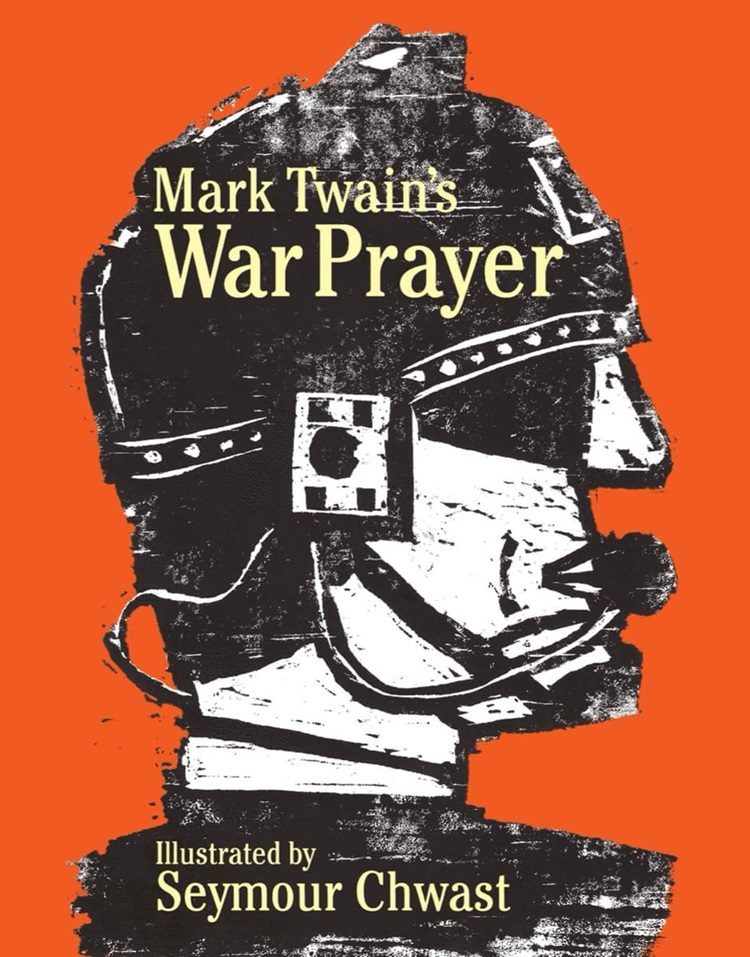
By the end of his life, Mark Twain (1835-1910) had made and lost fortunes many times over. He had suffered through the death of two of his daughters. His writing in final pieces like The Mysterious Stranger (1908) and War Prayer (1910), both posthumously published, was insightful as his previous work, but it had a bitter, almost cruel, outlook on life. It was missing the carefree observation style of Tom Sawyer (1876) or Huck Finn (1884). Fantagraphics has teamed legendary illustrator Seymour Chwast with the text of War Prayer for an interesting and unique new interpretation of the Twain essay.
Buy Mark Twain’s War Prayer by Seymour Chwast bookMark Twain had only been passed for 21 years when Seymour Chwast (1931-present) was born. Twain had lived through the worst war in American history (Civil War), many more conflicts like the Spanish-American War, and could see that the world was on the brink of what would become World War I. Chwast has lived through World War II, the advent of the Nuclear Age and the ongoing, cruel conflicts of the 21st Century. The idea to update our view of War Prayer is in good hands.
The book starts with an abridged essay by Twain called “The Lowest Animal” which shows the mood of Twain at this point in his life. The essay is built around a single observation that we have the direction of evolution incorrect. The “higher form” of animals are the ones who are not cruel to each other and do not make war upon others. “Man is the Cruel Animal. He is alone in that distinction,” says Twain. The words don’t have the same comedic tone that make his work endearing. This comes across like too much of a lecture.
This is followed by the “War Prayer” story with illustrations by Seymour Chwast. The story is established as a gathering of families during a time of war as they are about to send away their children to fight. There’s an outpouring of patriotism and celebration as they gather to hear a sermon by the local preacher. As he is speaking, a stranger (Jesus) approaches the pulpit and speaks to the crowd. His speech to the parents is designed to put the horrors of war into perspective. If they are praying for victory, they are also praying for the death of children of other parents on the other side of the world. Should they pray for all of that death? Or should the message be that love should win out in the end? I won’t ruin the final line, but you can probably guess from what I’ve said about Twain’s view of the world at this point in his life.
The illustrations by Chwast turn what would be almost cringeworthy to read as prose into a powerful message of peace. Breaking up what would be a very short story into more bite-sized phrases paired with illustrations is an effective way to control the pacing. It’s like a director using slow motion to call our attention to specific details. Chwast has always had a playful nature to his work and that’s just what this story needed.
There are three distinct acts to the story as illustrated. The establishment of the setting and war is done cleverly with bright, early 20th Century blends of images and words structured in what appear to be wartime posters. The second act through the arrival of Jesus has a combination of large figures and bright colors that reflect the excitement felt by the audience. Once Jesus starts his speech about the failure of war to accomplish anything, the imagery is much darker and covers the horrors of the past hundred years.
Twain’s cruel vision of parents who are seduced into sending their children to war needed the visual guide that Seymour Chwast provides. The weapons may have changed, but the horrors of death in war has endured. The story still feels contemporary and could end the same as it does here. The fresh take on Twain’s work is wonderful. I hope we haven’t seen the last of Chwast’s work.